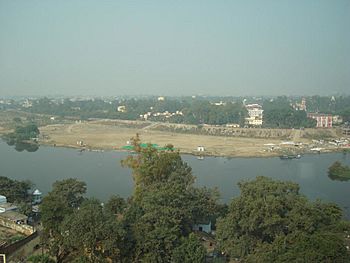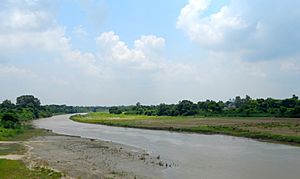Gomti River facts for kids
Quick facts for kids Gomti River |
|
|---|---|

Gomti River at Lucknow
|
|
| Other name(s) | Gumti River |
| Country | India |
| Physical characteristics | |
| Main source | Gomat Taal, Madho Tanda, Pilibhit, Uttar Pradesh Middle Ganga Plain 200 m (660 ft) 25°30′29″N 83°10′11″E / 25.50806°N 83.16972°E |
| Length | 960 km (600 mi) |
| Basin features | |
| Tributaries |
|
The Gomti River is an important river in India. It is a tributary, which means it's a smaller river that flows into a larger one. The Gomti flows into the mighty Ganges River. Many people believe the Gomti River is very special.
Some Hindu beliefs say the Gomti is the daughter of a wise man named Rishi Vashishtha. They also believe that bathing in the Gomti on a certain day, called Ekadashi, can wash away bad things. The Bhagavata Purana, a major Hindu religious book, lists the Gomti as one of India's five most important rivers. A rare shell called the Gomti Chakra is found in this river.
The Gomti starts as a small stream. About 20 kilometres (12 mi) from its beginning, it meets another small river called the Gaihaaee. The Gomti stays narrow until it reaches Mohammadi Kheri in Lakhimpur Kheri district. Here, other smaller rivers like the Sukheta, Choha, and Andhra Choha join it.
After these rivers join, the Gomti becomes wider and clearer. The Kathina river joins it at Mailani, and the Sarayan river joins it in Sitapur district. A very important river that flows into the Gomti is the Sai River. It joins the Gomti near Jaunpur. There is also a temple called Markandey Mahadeo where the Gomti meets the Ganges.
The Gomti River flows through many towns. After about 190 kilometres (120 mi), it enters the big city of Lucknow. It winds through Lucknow for about 30 kilometres (19 mi) and provides water to the city. Many towns are located along the Gomti River. These include Gola Gokaran Nath, Misrikh, Neemsar, Lakhimpur Kheri, Sultanpur, Kerakat, Jaunpur, and Zafarabad. The river even divides Sultanpur district and Jaunpur into two parts.
Contents
Why is the Gomti River Polluted?
The Gomti River faces a big problem: pollution. This happens at many places along its 940 kilometres (580 mi) journey through Uttar Pradesh. The main reasons for this pollution are waste from factories and dirty water from homes.
Factories that make sugar and alcohol often release their waste into the river. Also, water from homes and cities, called sewage, flows into the Gomti. This includes water from places where about 18 million people live. All these pollutants harm the plants and animals that live in the river.
To help clean the river, a large sewage treatment plant was started in 2008. This plant was supposed to clean a huge amount of dirty water every day. However, by 2014, it was not working well. Most of the dirty water and trash were still flowing into the river without being cleaned. This plant was meant to stop 23 major drains from pouring untreated waste into the Gomti.
What is the Riverfront Development Project?
For many years, especially around Lucknow, the Gomti River has been under stress. There are three main issues affecting it:
- Embankments: After a big flood in the 1970s, high walls called embankments were built along the river in Lucknow. These walls were meant to protect the city. However, they changed the river's natural floodplain, which is the flat land next to the river that gets covered by water during floods.
- Pollution: The Gomti has 40 natural drains that used to carry extra water into the river during the rainy season. This also helped refill the underground water. But over time, these drains started carrying dirty water and waste from homes and factories into the river.
- Development: Areas next to the river, like Gomti Nagar, used to be floodplains and fertile land. Now, they have houses and buildings. This has put more pressure on the river.
The Gomti River started shrinking in the late 1970s. By 2016, it was in a very difficult situation. Even though the government tried to clean it with projects like the sewage treatment plant, most of these efforts were not very successful.
Around 2012, a new government started looking into a project to develop the riverfront. They wanted to make it look like the Sabarmati Riverfront in Ahmedabad. Experts studied the plan and warned about possible problems. They said that making the river narrower could make the water flow faster and cause more stress on the riverbed. It could also make floods worse and threaten bridges.
Many environmental experts and river scientists were against this project. They saw it as a way to change natural river systems. Similar projects are also being planned for other rivers in India, like the Yamuna, the Hindon, and the Varuna.
Flooding and Health Concerns
During the monsoon season, when there is a lot of rain, the Gomti River can flood. When the floodwaters go down, they leave behind puddles and pits. These can become breeding grounds for mosquitoes. These mosquitoes can spread diseases like malaria and dengue, which can make people sick.
See also
 In Spanish: Río Gomti para niños
In Spanish: Río Gomti para niños
External links
- Sacred Rivers
- "Sewage kills thousands of fish in north Indian river". Babu Lal Sharma, Associated Press, 22 August 2003
- Markandey Mahadeo on Wikimapia
- Reference to Gomti River System





